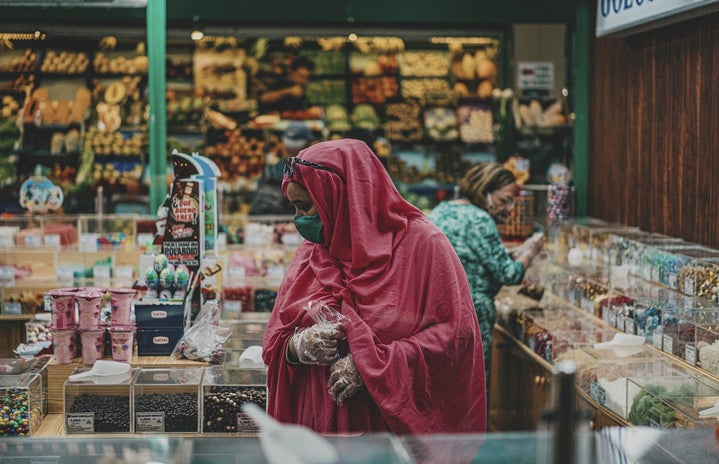THE DEATH OF MAHSA AMINI:
On the 13th of September 2022, Mahsa “Jina” Amini, a 22-year-old Kurdish-Iranian woman, visited the nation’s capital, Tehran, for a day out with family. Here, she was arrested by Iran’s ‘morality police’* and detained in a re-education centre for wearing her mandatory hijab too loosely and therefore not in accordance with the strict government standards. After her arrest, a witness reported that “during the journey to the police station she was tortured and insulted” and on arriving at the police station she began to lose her vision, eventually fainting.
Speaking to Sky News, her cousin, Erfan Mortezaei, recounts that it took “an hour and a half before she got to hospital”, and that upon her arrival, “she was already dead from a medical point of view” after suffering “a concussion from a blow to the head”. She then died on the 16th of September after 3 days in a coma. Iranian authorities responded by denying any mistreatment and claiming she died from “an underlying brain and heart condition” despite her family insisting “she was medically fit”.
*(One BBC article defines the morality police as “part of the national police force tasked with ensuring compliance with Iran’s Islamic values, including dress code […] Women can be stopped by [them] if they are considered to be ‘improperly’ wearing hijab, or headscarf, and taken into custody. Inside the ‘re-education centres’, detainees are given classes on the importance of the hijab and forced to sign a pledge to abide by the state’s clothing regulations before they are released. Many women resist detention and, as a result, are arrested by force.”)
PROTESTS IN RESPONSE:
Her death at the hands of Iranian authorities sparked, what the BBC reported as “unprecedented protests around the country”, as, according to Mortezaei, she had become the “voice of anger of the Iranian people”. These protests saw thousands of Iranian women (and men) taking to the streets, with the women publicly cutting their hair, burning their headscarves, and calling for the fall of Ayatollah Ali Khamenei, the Supreme Leader of Iran.
These protests were met with more violence from the Iranian police resulting in a still rising death toll (as of the 21st October, Arabian news channel, Alarabiya News, reported that this death toll had risen to 244 with over 12,500 protesters detained).
Among those killed was Sarina Esmailzadeh, a 16-year-old girl who was beaten to death by authorities “with batons at a protest in Gohardasht in Alborz province on 23 September”, according to Amnesty International”. Esmailzadeh would post videos on YouTube, often using her platform to express her anger at the human rights violations her and other Iranian women and girls experienced and her dreams of their liberation. After her death became known to the public, authorities claimed that it was caused by “suicide after she jumped from the roof of a five-storey building”.
Another 16-year-old girl, Nika Shahkarami, went missing hours after being filmed standing on an overturned bin, waving a burning headscarf and chanting “death to the dictator” along with crowds of protestors. Over a week later, her family learned she was dead. Again, Iranian authorities denied responsibility over her death, claiming they found her body “at the back of a courtyard” after she had fallen from a building. However, her mother, Nasrin, said she believes her daughter “was at the protests and killed there”. After members of her family were forced into making confessions to the Iranian media corroborating the authorities’ story, according to Omid Djalili (British-Iranian actor and comedian) recounting her story in an interview with radio station LBC, her mother refused to. After authorities threatened to burn her, she said the line, that has now become somewhat of a slogan for the protests, “You can’t burn women made of fire”.
OTHER PROTESTS:
Different protests from Iran have been shared on social media. One powerful Instagram video shows a woman dancing in front of the Azadi (Freedom) Tower in Tehran with her hair down. Captions over the video read that in Iran “dancing is deemed an ‘indecent’ act” and therefore punishable, and “not wearing a headscarf is a crime.” Other examples of women’s rights violations are also listed, such as:
- “Women cannot obtain a passport, or travel outside the country, without permission from a male guardian”
- “The legal age of marriage for girls is 13”
- “Women’s solo singing is unlawful”
Protests even entered the world of sport with Iranian climber, Elnaz Rekabi, competing at the IFSC Asian Championships in Seoul without a hijab. After her phone and passport were seized, she issued a public apology first on Instagram and then to Iranian State Media claiming it was “completely unintentional” and that a last minute call to climb caused her to “forget to put on [her] hijab”. However, a source has since told theBBC that these apologies were forced after authorities threatened her and her family. Returning to Iran after the competition, she left the airport to crowds chanting her name and calling her a ‘heroine’.
THE GLOBAL RESPONSE:
Protests echoing those in Iran have erupted around the world in countries such as Turkey, Canada, Iraq, USA, Syria, France, UK, Germany, Greece, Chile, Lebanon, Australia and more, as depicted in a video released by Amnesty International. Women are demonstrating solidarity with those in Iran by also publicly cutting their hair, burning their headscarves and demanding the reformation of Iranian women’s rights. One powerful placard reads:
“Scream, so that one day, a hundred years from now, another sister will not have to dry her tears wondering where in history she lost her voice”
Another one reads:
“The revolution has already started, and the world is watching”
In a statement on 22nd September, the United Nations called for an impartial inquiry into Amini’s death stating they “strongly condemn the use of physical violence against women and the denial of fundamental human dignity […]”. Many human rights groups have also condemned the Iranian authorities’ violent response to protests, with Human Rights Watch accusing the government of being quick to “crush dissent with a cruel disregard for life”.
As the internet and mobile networks have been disrupted and restricted in Iran, many emphasise how essential this global response and pressure is. Speaking to Sky News, Amini’s cousin, Erfan Mortezaei called on the international community to help them by ensuring that the regime is held responsible for her death.
Speaking to LBC, Djalili claims that this revolution “has been coming for 43 years”, ever since the Iranian Islamic Republic referendum of 1979. The Guardian reports, that for the 43 years since this event, Iranian authorities “have consolidated a ruthless hold on social and cultural mores, and have shown no sign of yielding to dissent of any kind”.
However, Djalili argues it could be different this time. He emphasises the power of the courageous Iranian women protesting in Iran, and then appeals to the rest of the world that “a major feminist movement [is] happening under our very eyes and if we don’t get behind it then shame on us”. Despite the many and various attempts by the authorities to silence Iranian voices, he argues that it is essential they are instead amplified by the rest of the world who can “be a voice… be their voice”.
This is an ongoing story, see live updates for more information.


